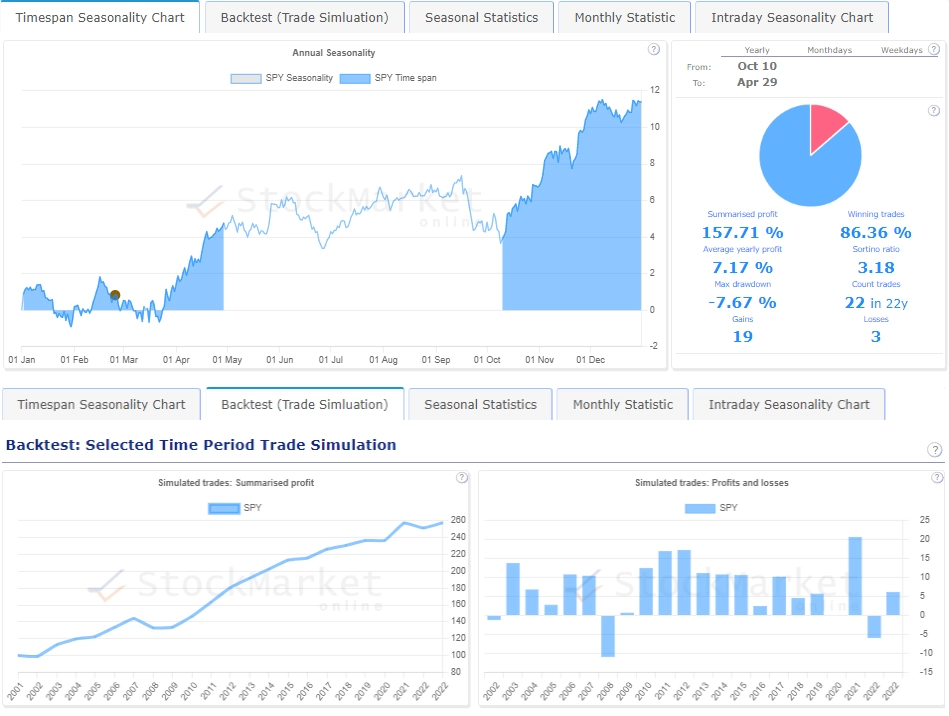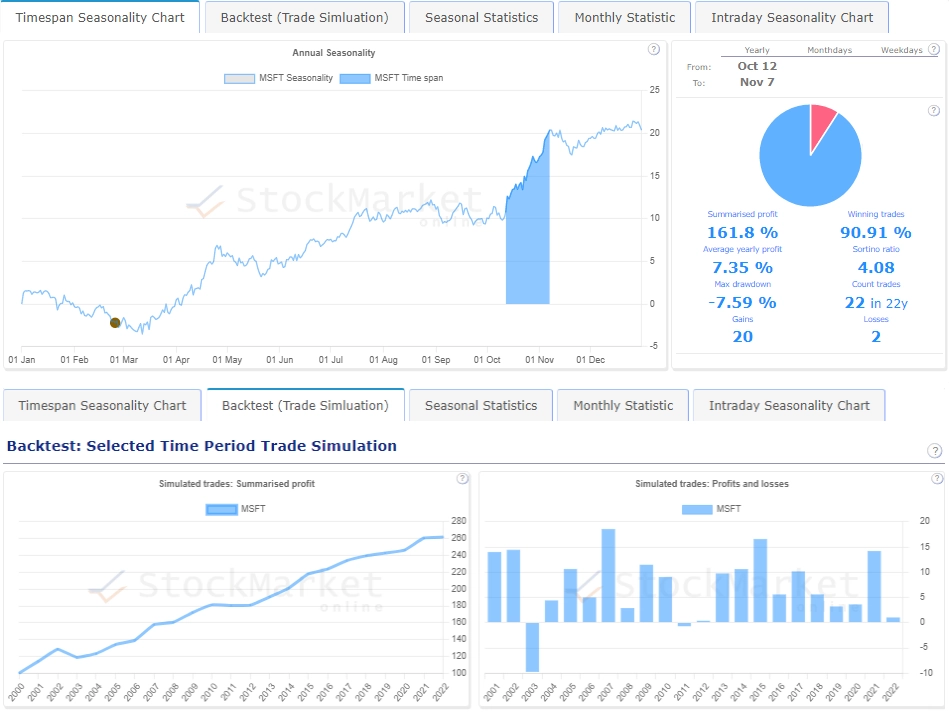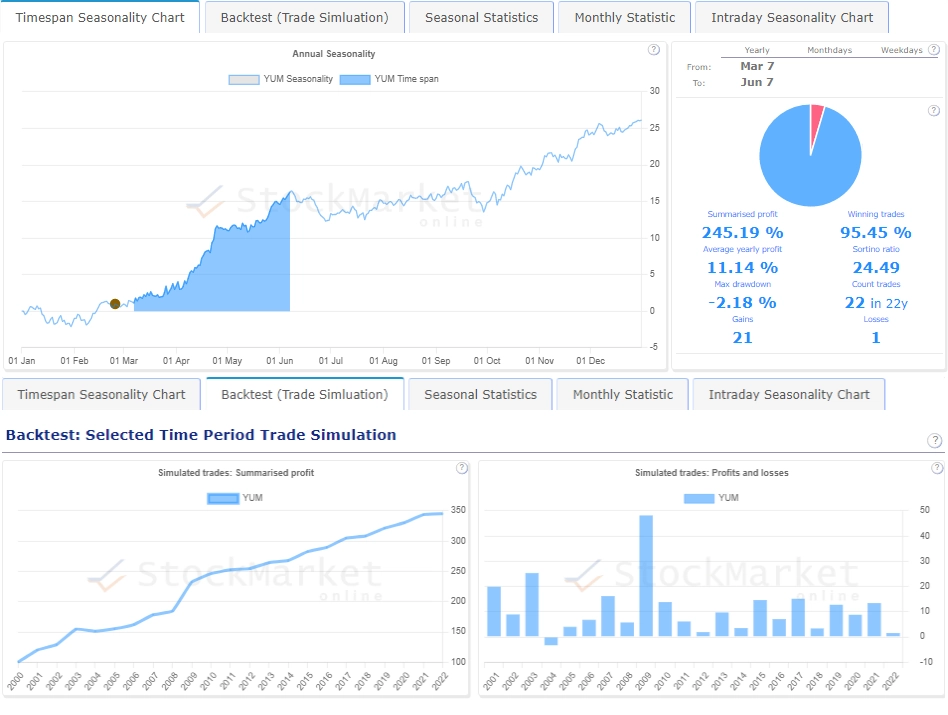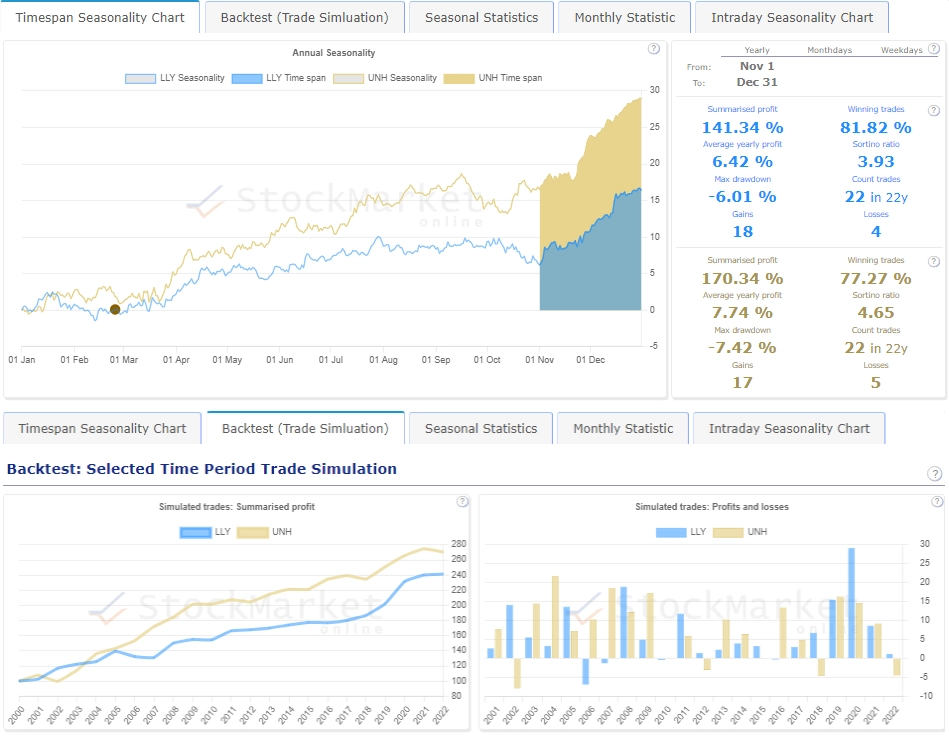Seasonality of Stocks
Create your own seasonality charts according to your needs with a few clicks at a very high professional level.
Seasonal Stocks are a very good technique to optimize your timing for entry and exit.
BUT, Be Careful.
Looking at a simple seasonal chart is not enough!
You need a backtest and KPIs to see the quality of the seasonal pattern.
The quality of your analysis determines your success.
A few seasonality examples of stocks.
Would you like more Seasonality Stock Charts. Our Seasonality Chart Analyzer offers free analyzable instruments. As a subscriber to our Seasonality Essential service, you have access to all instruments on our platform.
1. SPY (SPX) SP500 ETF - Sell in May
The best-known seasonal pattern on the stock market is: "Sell in may and go away but remember to come back in september!"
Prices rise much more from October to April than from May to the end of September.
2. MSFT: Microsoft Seasonality Chart
Microsoft almost always publishes better results than forecast in Q3.
This creates a stable, recurring pattern with a high hit rate from which you can profit.
3. YUM: YUM BRANDS
YUM! Brands, Inc. is the world's largest operator of quick-service restaurants.
Regularly, the share price rises for three months from the beginning of March.
The hit rate of this seasonal pattern has a hit rate of over 95%. The Sortino Ratio is very high, which suggests a very high and consistent performance.
4. LLY vs UNH: Seasonal Chart of Eli Lilly (LLY)
The seasonal chart of Eli Lilly and Company is particularly strong in the last 2 months of the year.
The price increases are regularly generated by positive corporate earnings.
The positive seasonal pattern can also be found across the healthcare sector.
The quality of your analysis determines your success.
You need a backtest to see if the recurring pattern has produced stable profits in each period and what drawdown has occurred.
Other statistical key figures and charts show qualitative details of monthly, weekly and weekday performance.
For the optimal time to buy, we show seasonal intraday charts for instruments with high trading volume.
If you want to use seasonality profitably, you need more than just a seasonality chart.
Our Seasonality Chart Analyzer shows you all relevant data for your analyses and your success.
Use the best seasonal patterns for your success.
Professional analysis tools for your success
All three Seasonality tools are part of the Seasonality Essential subscriber offer.
Create your own seasonal stock charts for all 20000 stock tickers in our database
Riding the Waves: How to Analyze Seasonal Stock Charts for Profitable Trading Strategies
In this article, we're going to take a deep dive into the world of seasonal stock chart analysis. We'll look at the key indicators to look out for, the most effective trading strategies to use and the most common mistakes to avoid. Whether you're a seasoned trader or just starting out, this guide will equip you with the knowledge and tools you need to ride the waves of the stock market and come out on top. So let's get started!
Understanding Seasonal Stock Charts
Seasonal stock charts are an excellent tool for traders who want to make informed decisions about when to buy and sell stocks.
The Benefits of Analyzing Seasonal Stock Charts
Finally, it can help traders manage risk by giving them a better understanding of the factors that influence stock performance.
Common Patterns in Seasonal Stock Charts
Traders should also be aware of the "Sell in May and Go Away" pattern, which suggests that traders should sell their stocks in May and buy them back in November.
Identifying Seasonal Trends in Different Industries
The travel industry tends to perform well during the summer months when people go on holiday. Traders looking to capitalise on seasonal trends should be aware of these industry-specific patterns and adjust their trading strategies accordingly.
Factors That Affect Seasonal Stock Charts
A strong economy can lead to increased consumer spending, which can drive up stock prices.
Traders should also be aware of the impact of interest rates, inflation and geopolitical events on the stock market.
Tools for Analyzing Seasonal Stock Charts
Traders should also be aware of the impact of news and other market events on a stock's performance.
Developing a Profitable Trading Strategy Using Seasonal Stock Charts
Traders should start by identifying the seasonal trends of the stock they are interested in trading. They should then develop a trading plan that takes into account their risk tolerance, investment objectives and trading style.
It's important to remember that no trading strategy is foolproof and traders should always be prepared for the possibility of losses.
Risk Management When Trading Seasonal Patterns
They should also be aware of the impact of leverage on their trades and use it judiciously. Finally, traders should always be prepared for the unexpected and have a risk management plan in place in the event of a market downturn.
Case Studies of Successful Traders Using Seasonal Stock Charts
Another example is Mark Hulbert, who developed a trading system based on the performance of the Dow Jones Industrial Average during the first five trading days of the month.
Traders can learn a lot from these successful traders and adapt their strategies to suit their own trading style and goals.
Conclusion
By understanding the key indicators, common patterns and factors that influence seasonal stock charts, traders can develop profitable trading strategies and manage risk more effectively.
While no trading strategy is foolproof, traders who are willing to put in the time and effort to analyse seasonal stock charts can gain a significant advantage in the market and ride the waves of the stock market to success.





